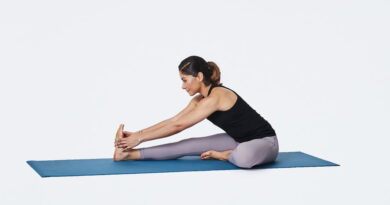Sarvangasana Yoga: The Ultimate Guide to Shoulder Stand Pose for Holistic Wellness
Table of Contents
Introduction
Sarvangasana Yoga, also known as Shoulder Stand Pose, is a revered yoga posture that offers numerous benefits for the mind, body, and spirit. Derived from the Sanskrit words “sarva” (meaning all) and “anga” (meaning body part), this asana involves balancing the entire body on the shoulders.
In this comprehensive guide, we will delve into the steps, benefits, variations, and precautions associated with Sarvangasana, allowing you to embrace this powerful yoga pose for optimal holistic wellness.
How to Perform Sarvangasana Yoga
To practice Sarvangasana, follow these step-by-step instructions:
Step 1: Begin by lying flat on your back on a yoga mat with your legs together and arms resting alongside your body.
Step 2: Inhale deeply as you engage your core muscles and lift your legs off the mat, bringing them perpendicular to the floor.
Step 3: Use your hands to support your lower back and hips, keeping your elbows close to your torso.
Step 4: Slowly extend your legs upwards, lifting your hips off the mat.
Step 5: Gently press your hands into your back for stability as you straighten your legs and point your toes towards the ceiling.
Step 6: Maintain the pose for 30-60 seconds, breathing deeply and relaxing your neck and facial muscles.
Step 7: To release the pose, bend your knees and gradually lower your legs back down to the mat.
Benefits of Sarvangasana Yoga
Regular practice of Sarvangasana Yoga offers a wide range of benefits, including:
a. Improved Circulation: The inverted position of Sarvangasana facilitates venous blood flow from the legs back to the heart, promoting healthy circulation throughout the body.
b. Strengthened Core and Shoulders: This asana engages the core muscles, including the abdominal and lower back muscles, while also strengthening the shoulders and upper arms.
c. Enhanced Thyroid Function: Sarvangasana stimulates the thyroid gland, which regulates metabolism and contributes to overall hormonal balance.
d. Calmed Nervous System: The pose has a calming effect on the nervous system, helping to reduce anxiety, stress, and insomnia.
e. Increased Lung Capacity: The chest expansion in Sarvangasana allows for deeper and more efficient breathing, enhancing lung capacity and oxygenation.
f. Improved Digestion: This posture massages the abdominal organs, promoting healthy digestion, alleviating constipation, and improving overall digestive function.

Variations of Sarvangasana Yoga
To add variety and challenge to your practice, consider exploring these variations of Sarvangasana:
a. Supported Shoulder Stand: Place a folded blanket or yoga bolster beneath your shoulders to provide additional support and stability.
b. Half Shoulder Stand (Ardha Sarvangasana): In this variation, only the lower body is elevated while the upper body and head remain on the mat.
c. Lotus in Shoulder Stand: Once in the full Sarvangasana Yoga, bring one foot at a time into a lotus position, with the top of the foot resting on the opposite thigh.
Precautions and Contraindications
While Sarvangasana Yoga offers numerous benefits, it is important to keep the following precautions in mind:
a. Avoid practicing Sarvangasana if you have any neck or shoulder injuries or conditions such as high blood pressure, glaucoma, or menstruation.
b. Always practice under the guidance of a qualified yoga instructor, especially if you are a beginner or have any underlying health concerns.
c. Ensure proper alignment and avoid excessive strain on the neck by keeping the weight on the shoulders and not the head.
Conclusion
Sarvangasana, the Shoulder Stand Pose, is a transformative yoga posture that can greatly contribute to your overall well-being. By incorporating this asana into your regular yoga practice, you can experience improved circulation, strengthened core and shoulders, and a calmer mind. Remember to practice with mindfulness, respect your body’s limits, and embrace the holistic benefits of Sarvangasana.





